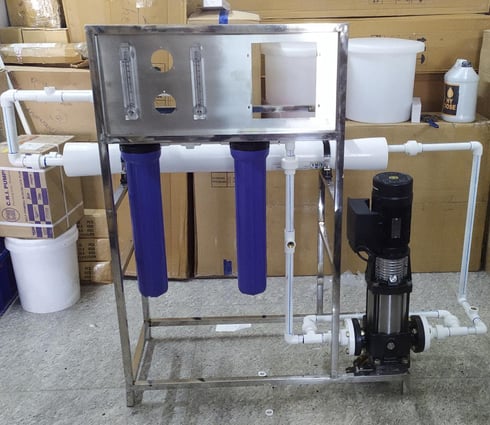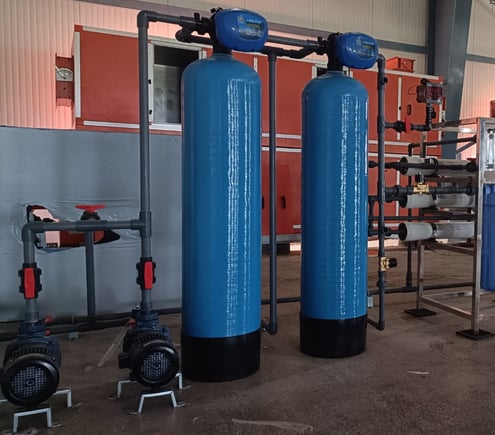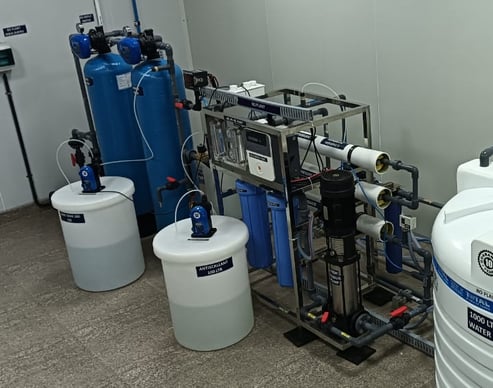A Reverse Osmosis (RO) plant is a water purification system that uses a technology called reverse osmosis to remove impurities from water. It is commonly used for drinking water purification, wastewater treatment, and in various industrial applications. Here's how it works:
Filtration: The water passes through a pre-filter to remove larger particles such as sediment, sand, and debris. This step helps protect the RO membrane from clogging.
Pressurization: The pre-filtered water is then pressurized using a pump to push it through a semi-permeable membrane.
Reverse Osmosis: The heart of the RO system is the semi-permeable membrane. It allows water molecules to pass through while blocking the passage of most dissolved salts, minerals, and contaminants. The pressurized water is forced through the membrane, leaving behind impurities.
Purified Water Collection: The purified water that passes through the membrane is collected, while the rejected impurities and concentrated brine solution are flushed away.
Post-Filtration: After passing through the RO membrane, the purified water often goes through a post-filter to remove any remaining impurities and improve taste and quality.
RO PLANTS


Products / Service
Water Softener
Projects
A water softener is a device or system used to treat hard water by removing the minerals that cause water hardness, primarily calcium and magnesium ions. Hard water can cause various issues, such as scale buildup in plumbing, reduced soap and detergent effectiveness, and a lack of lathering in soaps and shampoos. Water softeners work through a process known as ion exchange to alleviate these problems. Here's how a typical water softener operates:
Resin Tank: The heart of a water softener is a tank filled with ion-exchange resin beads or zeolite crystals. These resin beads have a negative charge and are designed to attract positively charged calcium and magnesium ions, which are the minerals responsible for water hardness.
Brine Tank: Connected to the resin tank is a brine tank that contains a highly concentrated salt (sodium or potassium chloride) solution. Periodically, the water softener goes through a regeneration cycle during which it flushes the resin tank with the brine solution.
Ion Exchange: When hard water passes through the resin tank, the calcium and magnesium ions in the water are attracted to the resin beads, and they exchange places with sodium or potassium ions from the brine solution. This exchange effectively removes the hardness minerals from the water and replaces them with sodium or potassium ions, making the water "soft."
Regeneration: After a certain amount of water has passed through the resin tank and the resin beads have become saturated with hardness minerals, the water softener initiates a regeneration cycle. During this process, the brine solution is used to clean and recharge the resin beads. The hard water minerals are flushed out of the resin tank and discharged as wastewater, leaving the resin beads ready to soften water again.
Purified Water Delivery: Once the regeneration cycle is complete, the water softener resumes softening the incoming hard water, providing soft water for use throughout the household.
A demineralization plant, often referred to as a "demineralized water plant" or "deionization plant," is a water treatment system designed to produce highly purified or demineralized water by removing nearly all of the dissolved minerals and ions from the water. Demineralized water is essentially devoid of ions and can be used in various industrial applications where a high degree of water purity is required. The process of demineralization involves the removal of both cations (positively charged ions) and anions (negatively charged ions) from the water. Here's how a typical demineralization plant works:
Pre-Treatment: Before entering the demineralization process, the feed water may undergo pre-treatment steps to remove suspended particles, organic matter, and other contaminants. These steps can include sedimentation, filtration, and chlorination.
Cation Exchange Resin: The first stage of the demineralization process typically involves passing the water through a cation exchange resin bed. This resin contains negatively charged functional groups that attract and exchange cations (such as calcium, magnesium, and sodium) in the water for hydrogen ions (H+).
Anion Exchange Resin: After passing through the cation exchange resin, the water flows through an anion exchange resin bed. This resin contains positively charged functional groups that attract and exchange anions (such as chloride, sulfate, and bicarbonate) in the water for hydroxide ions (OH-).
Mixed Bed Ion Exchange: To further enhance the quality of the demineralized water, some systems incorporate a mixed bed ion exchange unit, where both cation and anion exchange resins are combined in a single container. This stage ensures the removal of any remaining traces of ions.
Regeneration: Over time, the ion exchange resins become exhausted as they accumulate ions. To restore their capacity, the resins need to be regenerated. This process involves passing a concentrated acid solution through the cation exchange resin and a concentrated base solution through the anion exchange resin. These solutions strip the ions from the resins and recharge them, making them ready for the next cycle.
Water Quality Monitoring: Throughout the process, the water quality is continuously monitored to ensure that it meets the desired purity specifications.
Demineralized water produced by these plants is often used in industries where high-purity water is essential, such as power generation, pharmaceuticals, semiconductor manufacturing, and laboratory applications. It is important to note that demineralized water is not typically suitable for drinking because it lacks essential minerals, and it can be corrosive to plumbing and equipment due to its high purity.
Demineralization Plant




Copyright © All rights reserved. || Designed & Developed By Chidambaram Solutions
